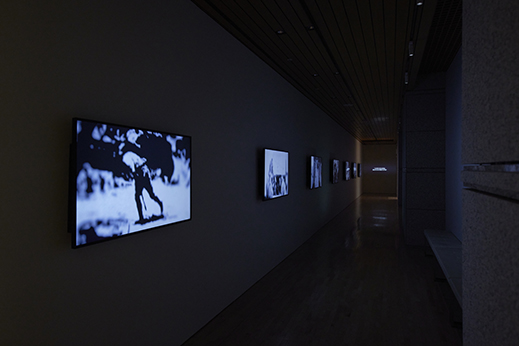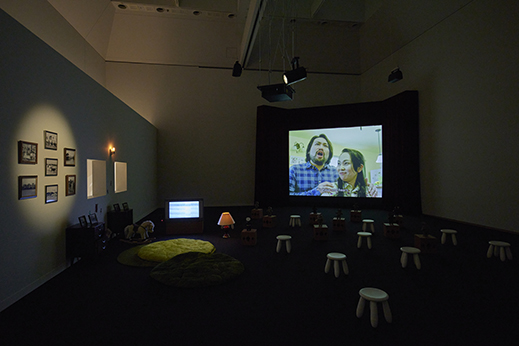| |
|
Here and There introduces art, artists, galleries, museums, and other cultural facilities around Japan that non-Japanese readers and first-time visitors may find of particular interest.
|
|
 |
|
|
 |
 |
Remembrance of Wars Past: Hikaru Fujii and Chikako Yamashiro at MOT
Alan Gleason |
 |
Chikako Yamashiro, A Woman of the Butcher Shop, 3-channel video installation (2012), Tokyo Contemporary Art Award 2020-2022 Exhibition, installation view at Museum of Contemporary Art Tokyo, 2022. |
Hikaru Fujii and Chikako Yamashiro, co-recipients of the Tokyo Contemporary Art Award for 2020-2022, currently share a winners' exhibition at the Museum of Contemporary Art, Tokyo (MOT) with installations that address the lingering impact on Japan today of World War II and the subsequent U.S. occupation of the country.
The thematic unity of the show is a coincidence, according to the organizers, Tokyo Arts and Space. Jurors for the award, which was launched in 2018 and is bestowed on "mid-career artists whose work is deserving of international attention," were honoring Fujii and Yamashiro for oeuvres that do not generally share this much in common. While Okinawa-born Yamashiro has shown a perennial concern with the long-term effects of the war and the continued presence of American bases on her home island, Fujii is known for video installations that look at a broad range of controversial historical events from a contemporary, often absurdist, perspective. Here, his subject matter happens to dovetail with Yamashiro's in a multimedia work about an episode in the war's immediate aftermath: the ambivalence of occupation forces in dealing with 153 Japanese war paintings confiscated because of their alleged propaganda value.
Interestingly, but also disappointingly, Fujii does not display any copies of the actual paintings. Instead, he has represented all 153 of them in absentia by constructing wooden frames, covered with scraps of wood and cloth, that match the dimensions of the paintings and carry labels identifying the title and artist of each work. The constructions are big: the wartime bureaucrats who commissioned the paintings favored monumental compositions, so most come in the standard size of 72 x 100 inches. (They also favored Western-style oils for their realism, despite the government's blanket condemnations of anything smacking of "Western" culture during that period.) At MOT these massive frames cover the walls as well as scaffolding that extends to the gallery's ceiling. It's an impressive, even dramatic sight, and the row upon row of blank facades drives home the point about the glaring absence of these works from public view.
 |
|
Hikaru Fujii, The Japanese War Paintings, installation with 153 paintings and captions (2022), Tokyo Contemporary Art Award 2020-2022 Exhibition, installation view at Museum of Contemporary Art Tokyo, 2022. |
Fujii has used this empty-frame conceit to call attention to censored content before. In his Record of the Bombing installation of 2016, blank canvases stood in for documentation of Japan's bombings of Chinese cities, part of a planned exhibition about the firebombing of Tokyo. That show never took place because conservatives opposed its "masochistic view" of history. Here, however, one craves at least a glimpse of the works that the MOT installation is about. Fujii does offer the tiniest of hints by mounting postcard-size reproductions of the paintings on the backs of some of these frames, but they are virtually indiscernible. He plays a similar game in another part of the installation, where video screens arrayed along a darkened corridor play loops of out-of-focus monochrome imagery that Fujii shot of microfilms of the confiscated works; once again the paintings themselves cannot really be made out. Interspersed with these images are occasional flashes of the occupation authorities' typed-up details on each painting.
What makes this video work the most compelling part of Fujii's installation is a soundtrack of dialogues reconstructed from records the artist obtained of discussions that took place among occupation staff in 1946. Performed in English by American voice actors, with Japanese translations projected on the wall, these imagined conversations bring to life the dilemma on the U.S. side over how to deal with the paintings. We learn that in late 1945 the War Department ordered GHQ in Tokyo to procure as many war paintings as possible for shipment to the U.S., ostensibly to be shown in exhibitions. When General MacArthur got wind of this plan, however, he objected that works of art could not be confiscated unilaterally unless they were demonstrably propaganda of no artistic value. In that case, however, the works might better be destroyed rather than displayed.
 |
|
Hikaru Fujii, The Japanese War Art, multichannel video installation (2022), Tokyo Contemporary Art Award 2020-2022 Exhibition, installation view at Museum of Contemporary Art Tokyo, 2022. |
There ensued a debate among GHQ staffers over how to treat these works -- a debate that remains unresolved in Japan to this day. Though the Japanese government's purpose in commissioning them was to portray the war in heroic terms for domestic consumption, the artists themselves rarely depicted battles as glorious triumphs, nor the enemy as inhuman monsters, if they showed enemy troops at all. Many of the works focus instead on the privations and self-sacrifice of Japanese troops both on and off the battlefield. Moreover, they were produced by established artists of some repute, among them the world-famous Leonard (Tsuguharu) Foujita. Arguments for their artistic merit were not without foundation and were made even by U.S. personnel. Those in charge went so far as to organize a private exhibition for occupation officials in 1946 at the Tokyo Metropolitan Art Museum in Ueno, where the paintings were being stored. Though there is no record of how the audience received them, in the end all were shipped to the U.S., where they were archived but not destroyed. In 1970 they were finally repatriated under "permanent loan" to the National Museum of Modern Art, Tokyo, where they remain in storage today, only occasionally trotted out for display, a few at a time, in other presentational contexts. There has yet to be a full-scale exhibition of these paintings at MOMAT or anywhere else.
Fujii does us a service by bringing our attention to this strange episode, which exemplifies the fraught relationship between art and politics while demonstrating how past wars can reverberate in the present in unforeseen ways. Still, his mode of presentation, however innovative and thought-provoking, seems a bit too detached and abstract to do justice to the actual content.
Yamashiro's video works, on the other hand, benefit from imaginative scenarios and vibrant cinematography that draw the viewer into the world of Okinawans struggling to negotiate the untenable position they find themselves in -- one of economic dependence on American military bases that run roughshod over the island's culture and environment. A consummate filmmaker, Yamashiro here showcases two major works that share a striking blend of whimsy and despair.
 |
|
Chikako Yamashiro, Chinbin Western: Representation of the Family, single-channel video (2019), Tokyo Contemporary Art Award 2020-2022 Exhibition, installation view at Museum of Contemporary Art Tokyo, 2022. |
The half-hour Chinbin Western: Representation of the Family (2019) centers around an Okinawan truck driver with a penchant for singing opera who takes a job hauling dirt for the Henoko landfill project, which is currently in the process of destroying a coral reef to expand a U.S. helicopter base. Despite his own misgivings, he accepts it as a necessary price for his family's survival until his young children start asking him, "Papa, is it true you're working for the landfill?" Further complicating his life is an encounter with a punkish, tattooed young artist who seems to be channeling ancient Okinawan spirits even as she tends bar for a living. Gorgeous seascapes alternate with slow pans across ravaged, denuded mountains. The Henoko dispute has dominated Okinawa politics for years, dividing the population along economy vs. environment lines with no solution in sight.
Even more beautifully filmed, and more surreal, is Yamashiro's 20-minute, three-channel video tour de force A Woman of the Butcher Shop (2012). This is an impressionistic look at a group of young women who make their living hacking up huge chunks of raw meat for hungry construction workers to barbecue. The meat stall is a black-market operation "tacitly permitted" to run on vacant land owned by the U.S. military. Nearby road construction brings a horde of workers to the stall every lunch hour -- great for business, until a convoy of trucks arrives to dismantle the shack and destroy even this precarious means of livelihood. There is something disturbingly predatory about the workers' outstretched hands and incessant demands on the butcher women, who for their part exhibit an almost erotic affinity for the animal flesh they chop up day in and day out. A surprising contrast comes in a sequence in which the women take the day off to swim together at a hidden beach, one of the few in the area still unspoiled by development. The long shots of them diving together or exploring caves in the cliffs are poetic, elegiac, yet somehow ominous. Without dialogue or overt political statements, the film powerfully conveys what it is like to eke out a living amid the absurd circumstances created by the overwhelming presence of American forces on the island.
 |
|
Chikako Yamashiro, A Woman of the Butcher Shop, 3-channel video installation (2012), Tokyo Contemporary Art Award 2020-2022 Exhibition, installation view at Museum of Contemporary Art Tokyo, 2022. |
Anata (2022), a new work Yamashiro created for this exhibition, consists of eight video panels showing a group of people silently walking back and forth across a stretch of coastal flats at low tide. Occasionally emerging from, then receding back into, the crowd is an elderly man who sometimes stands stock still, staring absently out at the ocean or back toward the camera. This is Yamashiro's father, who experienced the war in the Pacific firsthand. Yamashiro has noted that her father's memories of the war are fading with the onset of dementia, and she fears that this same loss is occurring on a societal scale as the survivors die off one by one.
While I found Yamashiro's work the more emotionally gripping of the two, her and Fujii's divergent approaches to exposing inconvenient truths about past events and their effect on the present form a complementary relationship that makes this a more cohesive and rewarding experience than most multi-recipient award exhibitions.
All photos are by Kenji Takahashi, courtesy of Tokyo Arts and Space.
|
|
|
| |
 |
Alan Gleason
Alan Gleason is a translator, editor and writer based in Tokyo, where he has lived for over 30 years. Since 2006 he has edited artscape Japan and written the Here and There column, as well as translating the Picks reviews. He also edits and translates works on Japanese architecture, music, and theater. |
|
|
|
|
|
|
|
|
|
 |
|